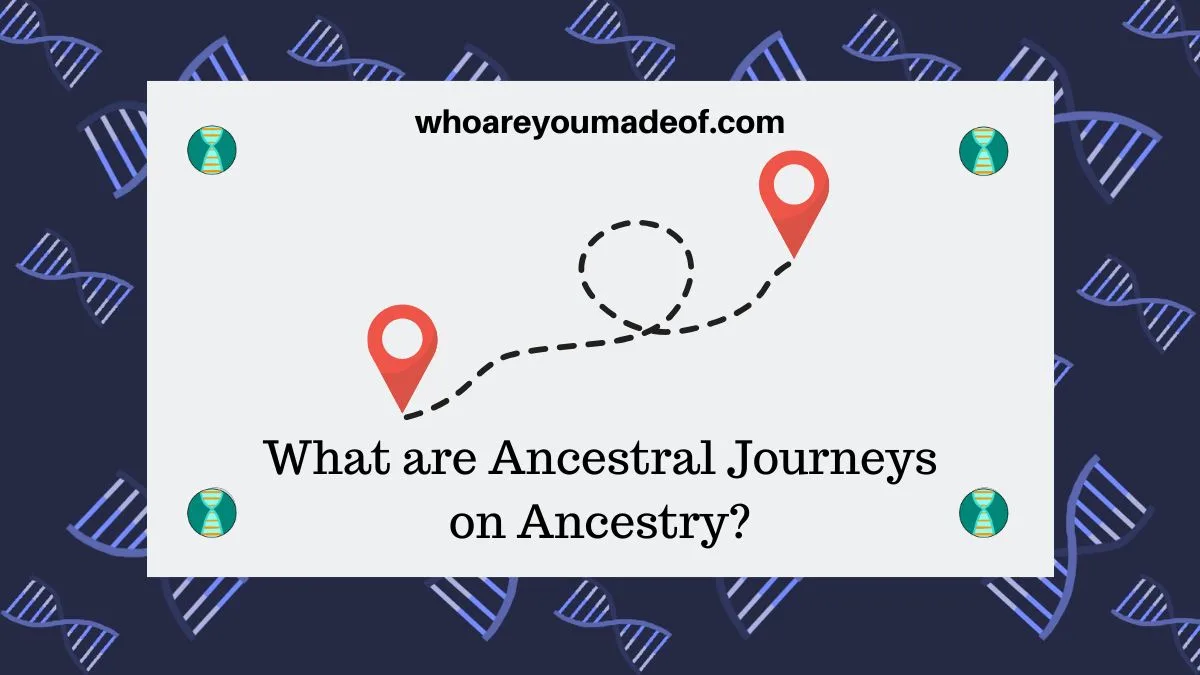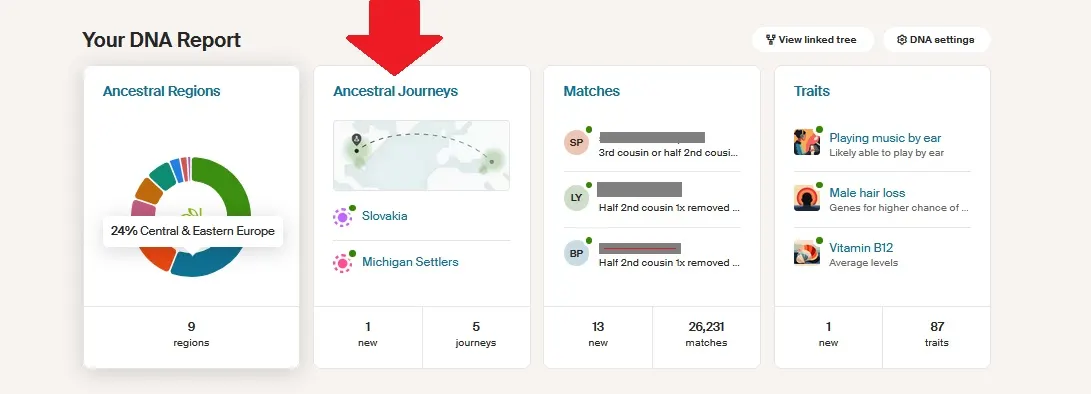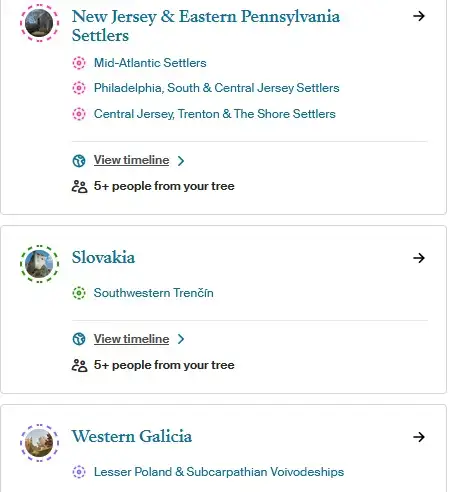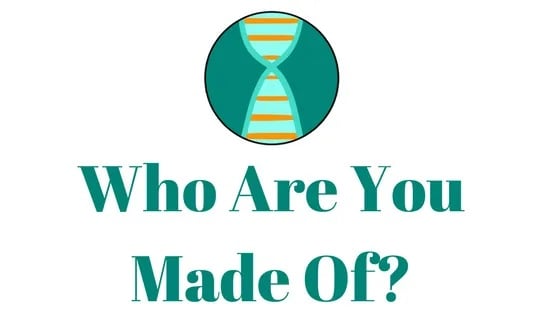Have you seen your Ancestral Journey on your Ancestry DNA results? In this post, learn where to find them, what they mean, and how you can use them to learn more about your ancestors.

Our Ancestry DNA results are fairly comprehensive, and there is a lot that we can learn from what our DNA can tell us about our ancestors.
One of the most interesting aspects of our results are our Ancestral Journeys. These results are very accurate, and can provide information and important context about the lives of your ancestors.
Below, find out where on your results to look for your Ancestral Journeys, what it means to see a Journey on your results, how these results are calculated, whether they are accurate - and more!
Where to see your Ancestral Journeys?
You can view your Ancestral Journeys by logging into your Ancestry results, and clicking on the blue Ancestral Journeys link that is next to your ethnicity estimate (i.e. your Ancestral Regions report).
The image below shows a red arrow pointing to where you should click. It is important to click to view all of your Ancestral Journeys, since you may not see the full list on your results overview.

Another great reason to click through and view the complete Ancestral Journeys result is to view additional information that is included along with each individual journey. I'll go more into this later on in this post.
When I click to see my full list of Ancestral Journeys, I see that I have six total in my list. However, several of my journeys also have several sub-journeys or sub-communities under the broader name for the Ancestral Journey.

For example, I have the New Jersey and Eastern Pennsylvania Settlers Ancestral Journey, but I have three smaller, more detailed sub-journeys on the list. These include the Mid-Atlantic Settlers, Philadelphia, South & Central Jersey Shore Settlers, and Central Jersey, Trenton, and The Shore Settlers.
Under my Slovakia Ancestral Journey, I see a more refined, specific Southwestern Trencin area. For Western Galacia, I see that my DNA matches the Lesser Poland & Subcarpathian Voivodeships.
What do Ancestral Journeys mean?
If you are assigned an Ancestral Journey, it means that you are a member of a group of Ancestry DNA customers who have ancestors who lived in the same part of the world at about the same time.
The Ancestral Journeys give you a glimpse into your family's relatively recent history, as Ancestral Journeys generally go back as far as 300 years. This is fairly recent compared to your Ancestral Regions estimate, which can reveal information about your ancestors going back 1,000 years or more.
How do they calculate your Ancestral Journeys?
Ancestry calculates our Ancestral Journeys by looking for a DNA connection between our DNA sample and reference panels for each Ancestral Journey. The company's software compares our DNA to each of the Journey reference panels to see if we are a match, and if we are, we get the Ancestral Journey on our results.
The reference panels are developed by using special algorithms to analyze billions of DNA connections between millions of Ancestry DNA customers to look for groups of people who share longer DNA segments that are likely to be identical-by-descent because they were inherited from a shared ancestor. This process is described as "community detection" in their white paper.
The amazing thing about the technology is that they can run this analysis within broader communities to identify groups of people who are likely more related to each other than they are related to the bigger group. This is how we get some of the more narrowly-defined sub-Ancestral Journeys.
Once groups of people are identified, user-generated family tree information and Ancestral Regions admixture data is used to determine what the members of the group have in common with each other. This could include ancestors who were all born around the same time at a similar location, or being from the same source population.
To define an Ancestral Journey, recent history information is required in order to give context to how and why these people have a connection to a specific place or migration, even if they no longer consider themselves to be part of that group or live far away from where the group came from.
How accurate are Journeys?
Ancestral Journeys are considered to be very accurate, perhaps even more accurate than our ethnicity estimate. This is because Ancestral Journeys are calculated based on long, identical-by-descent DNA segments that we share with other people.
When two people share a long DNA segment with each other, it is almost always due to having a relatively recent shared ancestor. So, our membership to the groups of people detected by Ancestry's algorithm are almost irrefutable.
When I look at my own Ancestral Journeys, and those of both of my parents, I usually know who it is in my tree who lived in or migrated to that area. The results match what I know about my family tree fairly well.
I'm always surprised at how detailed the results are. For example, when I look at my Slovakia - Southwestern Trencin results, the purple area encompasses the place where my ancestors lived.

During my years of DNA match research, I have stumbled upon a good number of people who share DNA with me and who also have ancestors from this area. I can't always figure out how we are related, however, due to the fact that not all of my matches have family trees.
Even when people from this region do have family trees, I often see more than one surname that we share in common. Due to genetic isolation and pedigree collapse, we may be related to each other in more than one way.
I'm sure that Ancestry's community detection algorithm was able to pick this group of people out fairly easily!
What can you learn from your Journeys?
If you click on a specific Ancestral Journey in your results, you will find a lot of additional information. As I mentioned above, you might see sub-Journeys linked to more specific regions.
Furthermore, if you are an Ancestry Pro Tools subscriber, you will even be able to see which side of the family connects you to the Ancestral Journey. To see this information, scroll down on the individual Ancestry Journey page until you see "Which parent passed it down?".
If you have a family tree connected to your DNA results, Ancestry might be able to suggest people from your tree who may be responsible for your connection to the Ancestral Journey group.
You can also view the timeline associated with each Ancestral Journey. The timeline includes data from migrations identified in your Ancestral Journey group, as well as important historical context that can help you understand more about your ancestor's life experience.
Occasionally, an Ancestral Journey might be able to help point you in the right direction in your family tree research. My most recent brick wall is my great-great grandmother.
I've been working on her line for so long with no success. I've mentioned her several times in my weekly newsletters over the years, and I've even said things like "this year is the year I discover where she came from", to no avail.
This is why I was especially interested to find Western Galicia in my Ancestral Journeys. It's the part of Poland that I believe my great-great grandmother is from based on the witnesses I identified on a baptismal certificate that I found for my great-great uncle.
Several of my mother's siblings have also tested their DNA, and one of my aunts was assigned a more specific region within Galicia called "Zawadka Brzostecka | Olpiny | Zolkow". This region is circle only about 20 miles across!
If it's as accurate as the other Ancestral Journeys results that I've seen, I have a good chance of eventually finding proof that my great-great grandmother (or her ancestors) lived in this region of what is now Poland.
Will your Ancestral Journeys change over time?
As many Ancestry DNA customers already know, our DNA results do go through periodic updates. Typically, we can expect to see our Ancestral Regions (ethnicity estimate) update about once per year.
Ancestry has said that their Ancestral Journeys will update as the updates are available, and that they are not updated on a set schedule. This means that you should check back a few times a year to see what's new on your results.
I always recommend people check their results a few times each year anyway, even if they are not actively researching their family tree. This is because we could potentially get new DNA matches a few times a week, and our ethnicity estimate will definitely update once per year.
With the addition of updates to Ancestral Journeys, there is sure to be always something new we can learn from our DNA results.
Conclusion
I hope that this post has helped you understand more about your Ancestral Journeys and what they can tell you about your ancestors.
If you have any questions about something that you read in this post, or if you have an Ancestral Journey that surprised you, please join in the discussion below.
Thanks for stopping by and reading today!
